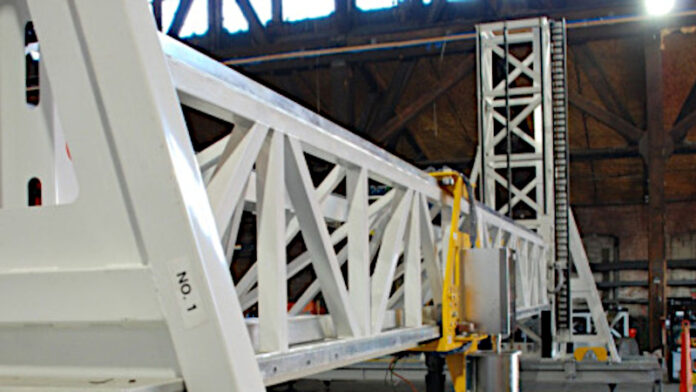
The housing market has not kept up with demand for affordable housing in Iowa, leading to a new Iowa State University project that will work to find faster, cheaper solutions through 3D-printed homes.
The Iowa Economic Development Authority (IEDA) has announced a $1.4 million Strategic Infrastructure Program (SIP) grant for the ISU College of Design’s 3D Affordable Innovative Technologies (3D AIT) Housing Project.
Pete Evans, assistant professor of industrial design; Julie Robison, program manager for the Institute for Design Research and Outreach and community and economic development specialist for ISU Extension and Outreach; and Kevin Kane, associate dean for research and outreach in the College of Design, have been working with IEDA toward funding the overarching project over the past two years. The project, when fully funded, is proposed to be $2.14 million, including the SIP grant.
The project comes in response to high housing demand in rural communities fueled by ex-urban migration, growing acceptance of remote work, and rising costs of urban living. There is a lack of quality, affordable housing in rural communities to accommodate this growth, however.
“Since about 2008, there has been a shortage in the residential housing market,” Evans said. “That’s part of why, for the past couple of years, we have seen a massive surge in pricing and demand for housing. That shortage is something that we have to figure out a way to overcome to be able to attract and support a workforce. If we have any desire to maintain and grow our communities, housing is a large piece of that.”
Advanced technologies lower risk, waste and cost
Housing technologies have not changed much in the last century, and materials have been shown to not be resilient against disasters like the 2020 Iowa derecho or annual flooding. The team will work with Brunow Contracting on a demonstration build as part of a 40-unit development in Hamburg, Iowa, in 2022 as part of the community’s recovery efforts from 2019 flooding. This build will help the team to understand design, affordability, zoning and building codes, community engagement, and training as the project moves forward.
Using advanced technologies to 3D-print housing can lower construction risks, reduce material usage and waste, allow faster response to natural disasters, and provide affordable, resilient and sustainable housing, Evans says.
The $1.4 million grant will fund equipment and materials, including a 3D construction printer, 3D concrete construction printing materials and components, on-site robotics, mobile CNC machining, web technologies, and virtual and extended reality.
Additional funding will help the multifaceted project:
- Develop a curriculum in partnership with Iowa Central Community College to train future workers in advanced home construction;
- Conduct research in material development and testing, zoning and building codes and community engagement; and project management; and
- Engage with companies across the state – at demonstration sites or through ISU Extension and Outreach – as project assets, technologies and infrastructure are made available.
“Nationwide, rural housing issues are often overlooked,” said Luis Rico-Gutierrez, dean of the College of Design. “For Iowa State, they are central to our priorities as a land-grant institution. This funding allows us to address all aspects of the process, from planning to developing new building codes through construction and the impact on the quality of our lives.”
“The Strategic Infrastructure Program supports first-class, innovative projects that provide a competitive advantage for Iowa’s industries,” said Debi Durham, executive director of the Iowa Economic Development Authority and Iowa Finance Authority. “This project checks that box and more. 3D printed technology is not just a disruptor to the construction industry, it provides a solution for quality, affordable housing in the state, which the Governor’s Economic Recovery Advisory Board has recognized as critical to growing Iowa’s economy.”
Ms. Robison will serve as project manager for the project. She will also lead the Iowa Affordable Housing Survey to help compare costs of the team’s demonstration builds to other affordable housing initiatives.
“Affordable housing is a crucial issue across the state of Iowa — both in rural and urban areas — and this work will aim to help the industry and funders understand how to provide housing in the most affordable and most efficient manner, especially when dealing with disaster recovery,” she said. “We hope that new technologies and more efficient, affordable ways of providing housing will be shared throughout our Extension and Outreach work in affordable housing as a result.”
This project will involve multidisciplinary collaboration across Iowa State, including Mr. Evans, Ms. Robison and Mr. Kane; Shelby Doyle, Stan G. Thurston Professor in Design Build and associate professor of architecture; Chengde Wu, associate professor of architecture; Nick Senske, assistant professor of architecture; Carl Rogers, associate professor and chair of landscape architecture; Daniel Kuhlmann, assistant professor of community and regional planning; Erin Doran, assistant professor in the School of Education; Sara Nelson, STEM specialist for ISU Extension and Outreach and the School of Education; and multiple graduate and undergraduate research assistants.




